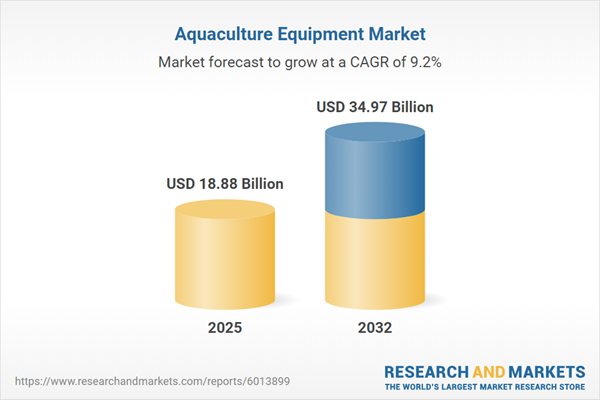Speak directly to the analyst to clarify any post sales queries you may have.
Senior leaders in the aquaculture equipment market are refocusing investment priorities to tackle regulatory complexity, strengthen sustainability performance, and leverage digitalization for greater operational agility. Tomorrow’s competitive advantage is shaped by how quickly organizations align strategy, technology, and processes in an environment marked by accelerating change.
Aquaculture Equipment Market Snapshot
The global aquaculture equipment market is on a strong expansion path, with market size forecast to rise from USD 17.29 billion in 2024 to USD 34.97 billion by 2032, reflecting a CAGR of 9.20%. Ongoing sector growth is closely tied to automation advancements, rapid adoption of water quality monitoring solutions, and the availability of compliance-oriented digital tools. These developments are supporting organizations as they scale operations, improve transparency, and consistently meet both operational and regulatory benchmarks. Regional growth trajectories vary, with rapid adoption seen in Asia-Pacific and steady regulatory advancement in North America and Europe, shaping unique market opportunities and implementation challenges.
Scope & Segmentation of the Aquaculture Equipment Market
- Equipment Types: Includes aeration and oxygenation technologies, automated feeding systems, biofiltration and filtration devices, pumps, valves, handling implements, nets and cages for species containment, UV sterilizers, sedimentation, ozone solutions, and processing machinery. These types support enhanced productivity, ensure compliance with regulatory standards, and reinforce product quality in high-throughput environments.
- Farm Types: Encompasses cage culture operations, floating and offshore cages, land-based recirculating farms, flow-through installations, and pond systems. Choosing the right farm setup is central to addressing targeted production needs and maximizing efficiency.
- Water Types: Solutions are designed for both freshwater and marine environments, accommodating the full range of ecological and operational variables present across global aquaculture operations.
- Species: Addresses the equipment needs for finfish such as salmon and tilapia, crustaceans including shrimp, crab, lobster, and mollusks like oysters, clams, and mussels. Selection is tailored to the biological requirements and production cycles of each species group.
- Application Stages: Spans technology for hatcheries, grow-out operations, processing, and packaging—enabling traceability and compliance management through every step of the supply chain.
- Regions: Primary markets include North America, South America, Europe, Middle East and Africa, and Asia-Pacific. Within these, the United States, Canada, Brazil, UK, Germany, France, China, and India demonstrate distinct adoption patterns, reflecting local technological infrastructure and policy approaches.
- Key Companies: Leaders such as Pentair Inc, AKVA Group ASA, Xylem Inc, Evoqua Water Technologies LLC, AquaMaof Aquaculture Technologies Ltd, Bio-UV Group SA, Innovasea Systems Inc, Oxycom N.V., Novatec Biosystems LLC, and Optimarin AS drive reliable, compliance-focused product innovation across the segment.
Aquaculture Equipment Market: Key Takeaways for Decision-Makers
- Centralized asset management platforms streamline oversight and responsiveness, facilitating adherence to rapidly evolving compliance and audit requirements and supporting digital transformation in aquaculture operations.
- The integration of smart automation not only reduces manual intervention but also helps maintain process consistency in complex, multi-stage production scenarios.
- Adopting modular designs increases operational flexibility, making it possible to efficiently update equipment to align with changing species profiles, regulatory directives, or process flows.
- Procurement strategies emphasize compatibility and site-specific customization, supporting organizational alignment across operational partners and ensuring asset longevity.
- Expanding the deployment of digital tools throughout the supply chain strengthens process traceability, which fuels both compliance gains and ongoing process optimization.
- Regular collaboration with technology providers and planned equipment upgrades are critical for meeting shifting sustainability objectives, sustaining resilience, and ensuring continued market relevance.
Tariff Impact: Navigating Cumulative Tariff Measures
Recent shifts in United States tariff policy are prompting organizations to diversify suppliers and deepen relationships with regional manufacturers. Strategic procurement now hinges on thorough cost assessment, forward-looking planning, and customization, which, in turn, helps buffer against potential supply chain volatility and regulatory uncertainties.
Methodology & Data Sources
This report combines in-depth interviews with manufacturers and sector experts, site assessments, and a hands-on review of supply chains. This approach ensures the guidance is actionable and well-suited for organizations seeking to refine procurement strategies and stay competitive in dynamic markets.
Why This Report Matters
- Enables rapid market segmentation and targeted resource allocation for leaders navigating operational complexity in aquaculture.
- Clarifies top compliance and operational priorities, facilitating proactive strategic response to policy and technology trends.
- Provides actionable recommendations for integrating new technologies and strengthening supplier relationships to drive organizational value.
Conclusion
Forward-thinking investment in reliable aquaculture equipment and robust supplier networks underpins effective risk management and business resilience as the sector evolves. Aligning technology and strategy provides a substantive foundation for long-term industry leadership.
Additional Product Information:
- Purchase of this report includes 1 year online access with quarterly updates.
- This report can be updated on request. Please contact our Customer Experience team using the Ask a Question widget on our website.
Table of Contents
3. Executive Summary
4. Market Overview
7. Cumulative Impact of Artificial Intelligence 2025
Companies Mentioned
The companies profiled in this Aquaculture Equipment market report include:- Pentair Inc
- AKVA Group ASA
- Xylem Inc
- Evoqua Water Technologies LLC
- AquaMaof Aquaculture Technologies Ltd
- Bio-UV Group SA
- Innovasea Systems Inc
- Oxycom N.V.
- Novatec Biosystems LLC
- Optimarin AS
Table Information
| Report Attribute | Details |
|---|---|
| No. of Pages | 196 |
| Published | October 2025 |
| Forecast Period | 2025 - 2032 |
| Estimated Market Value ( USD | $ 18.88 Billion |
| Forecasted Market Value ( USD | $ 34.97 Billion |
| Compound Annual Growth Rate | 9.2% |
| Regions Covered | Global |
| No. of Companies Mentioned | 11 |









